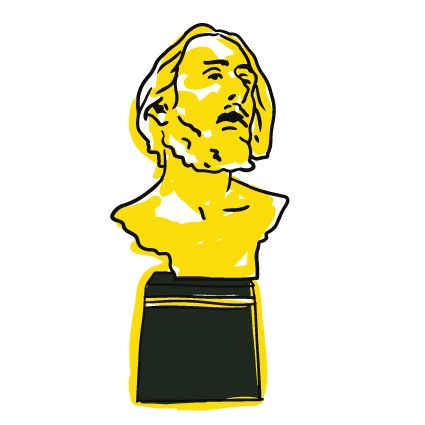
Csikász Imrének (1884–1914), Veszprém máig legjelentősebb, fiatalon eltávozott szobrászművészének torzóban maradt életművében több szempontból különleges, egyedülálló helyet foglal el 1908-ban Brüsszelben készült, kettős címmel ellátott bronzszobra. Története is rendhagyó, hiszen eredeti címét, a Flamand halász elnevezést maga a művész módosította Krisztusfejre, amikor művét hazaküldve báró Hornig Károly püspöknek ajánlotta. A Laczkó Dezső Múzeum is a püspök egykori ajándékának köszönheti az értékes szobrot, amely Laczkó Dezső új intézményébe került még 1917-ben.
Kétségtelenül főműről van szó, amely élő modell alapján készült, bizonyára a belgiumi útja során látott, valóságos halászembernek az őt megragadó arca alapján. A flamand halászarc nem mindennapi. Eltér a művész minden más munkájától mozgalmas felületkezelése, nyugtalan, expresszív jellege miatt. Érett korú férfiarcot láttat, a rendkívül merész, modern megformálás szakít az akadémikus hagyományok frontális merevségével, mellőz minden klasszicizáló, egyensúlyt kereső elvet.
A kifejezetten profán természetű ábrázolás, a naturális hűségű megjelenítés újabb, szakrális dimenziót kap, átértékelődik a cím megváltoztatásával. Ha el is tér a Krisztus-interpretációk ikonográfiájában általában megszokott méltóságteljes, szelíd Isten-arctól, annál megdöbbentőbb erővel sugallja a Megváltó emberarcát, a földi életet vállaló és a vele járó kikerülhetetlen küszködés nyomát viselő emberarcot.
Ez a realisztikus, naturális stílustörekvés összességében is jellemző Csikász Imre alkotásaira, ismert portrészobrainak tömbszerűségéhez képest azonban ez a nyugtalan, felfokozott, tépett karakterű megközelítés jelentős eltérést mutat. Határozottan különbözik Rómában készült szobrai (Fiatal lány, Ülő lány) klasszicizáló, letisztult szellemiségétől is. A korábbi müncheni útja során a Művészeti Akadémián megismert merevebb szemlélet után a brüsszeli szabadabb légkört, szimbolista szellemet, Victor Rousseau hatását tükrözi, amely magyarázhatja a különleges, expresszív megközelítést, amelynek később sincs folytatása pályáján.
Tevesz Mária
művészettörténész
Erre haladjon tovább:
A következő állomásra néz a szobor, valami lóg a salgópolcról.
Imre Csikász (1884-1914), Veszprém’s most significant sculptor who passed away young. In his incomplete oeuvre, his bronze sculpture, created 1908 in Brussels, with a dual title, holds a unique and exceptional place in his life’s work in several respects. Even its story is extraordinary, since its original title “Flemish Fisher” was changed to “Head of Christ” by the creator himself, when he sent the finished sculpture back home, as a gift to bishop Károly Hornig. The Laczkó Dezső Museum owes this valuable sculpture to the bishop, who gifted this piece to the museum in 1917.
This artwork is undoubtedly a major work of the sculptor, which was based on a live model. The face most likely belonged to a real fisherman whose face captivated the artist during his travels in Belgium. The Flemish fisher's face is unusual and differs from all previous works of the artist with its dynamic surface treatment and restless,expressive nature. It depicts a mature face of a man, its exceptionally bold, modern form breaks away from the academic tradition’s rigid frontal depictions, it sets aside every classicising and balance-seeking principle.
Its depiction is exceptionally profane in nature, its naturalistic accuracy gains a new sacral dimension and its meaning goes through revaluation with the change of the title. Although it differs from the traditional, dignified “Face of God” depictions of Christ, it suggests with a more astonishing force the human face marked by the struggles of the Saviour, who took on earthly life and the unavoidable difficulties that followed it.
This realistic, naturalistic stylistic aspiration was overall present in the works of Imre Csikász. It significantly differs from the blockiness of his well known portrait-sculptures with its restless, exaggerated, ragged approach to the character. It also deviates from the classicising and refined mentality of his sculptures created in Rome(Young Girl, Sitting Girl). During his earlier travels in Münich. After the more rigid approach encountered at the Academy of Fine Arts during his earlier trips in Münich, the freer atmosphere and Symbolist spirit of Brussels, influenced by Victor Rousseau is reflected in his work. This might explain the unique, expressive approach which can not be seen again during his career.
Mária Tevesz
art historian
Proceed to this:
The statue is looking at our next destination; something is hanging from the ‘Salgó’ shelf.